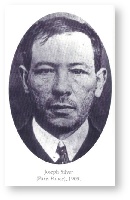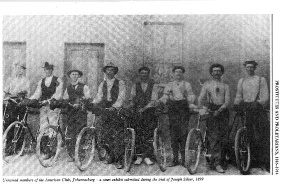- Created by Katharina Theresa Klein, last modified on 23. Jun 2013
You are viewing an old version of this page. View the current version.
Compare with Current View Page History
« Previous Version 11 Next »
Prostitution as a Business started in South Africa at a time, when Europe was trying to get rid of the “women of ill fame”. Poor women, without any chance of a better life in Europe, bought cheap ferry tickets from Germany to South Africa, to find happiness and wealth on another continent.
“If it was the glitter of gold and the pursuit of profit at first attracted hundreds of diggers to the Witwatersrand in the mid-1880s, then it was the sustained and changing demands of a fully fledged mining industry over the next two and a half decades which continually transformed that society (…) amongst many other distinctive decelopments, the sexual composition of Johannesburg underwent a fundamental change.” (Van Onselen 1932:104)
From the 1890s on, there was a beginning of well-balanced sex ratio:
1896 in ratio:
White | 1,78 men | to | one women |
Black | 10,5 men | to | one women |
From 1892 on, it became clear to everyone that the gold fields in Witwatersrand were going to prove to be a lasting proposition. Many mineworkers from all around the world moved to South Africa. Cheap fares from the German East African Shipping Line provided direct contact with the ports of Europe. Heavy industry in Europe excluded female workers from the labor market. Women sought economic refuge in prostitution.
The Great Depression of 1873-96 had a great influence on women moving to South Africa.
Brothels in central Johannesburg, October 1895
Number of brothels ‚Nationality‘
36 French
26 Unknown
20 German
5 Russian
2 Austrian
2 Belgian
2 American
2 Cape Colored
1 English
1 Australian
97 Total
Most of the prostitutes were white, others were cape-colored, only a small number were black. The women rented small rooms in canteens and hotels, where they were provided with a steady stream of male customers. Some of the part-time prostitutes worked as barmaids within the establishment itself. Bar-owners accepted the business because prostitutes tended to attract male customers to the bars and hotels and there was increasing consumption of liquor. It only lasted a short while until the canteen keepers organized themselves into a professional association.
Due to the strong support from canteen keepers, landlords and hotel owners, the Sanitary Boards was discouraged to take any legal action against prostitution. During this time there was a link between the trade in sexual favors and alcohol and the relative absence of organized prostitution.
Contagious Disease Act: In 1885 the Cape Parliament forced the prostitutes to registration and compulsory medical examination.
In 1896 more than 10% of all white women, living in Witwatersrand, were full time prostitutes.
It didn’t take long until small criminals like thieves and gamblers came to the city and brought with them the commercialized sex. Those criminals were called pimps, they opened many illicit bars and disorderly houses, the Police mostly took profit out of their criminal business.
Due to the lack of proper sexual protection, venereal diseases spread even faster than crime in Witwatersrand. The president of Johannesburg S.J. P. Kruger, was the first to recognize that illegal prostitution was out of control. Prostitution was an embedded part of the social structure, which made it difficult to set laws and provision.
The local middle class felt threatened by the public existence of prostitution and its increasing number. They got a stronger voice in public and press.
In 1897, a group called “Bowery Boys” (formerly located in New York) became professionals in black mailing, bribery and corruption. Their wives played an important role as madams in the houses of pleasure.
“A cunning, ruthless and violent man, Silver was soon the undisputed leader of the former New York gangsters, and earned for himself the unofficial title of ‘King of the Pimps’ in Johoannesburg” – (Van Onselen 1932:119)
The “Bowery Boys” founded the “Americas Club” in 1898 as a brothel but unofficially they were also involved in the trade of women.
„Advertisements placed in British or continental newspapers offered young women an assisted passage to South Africa in order to take up well-paid positions as ‚barmaids‘ or ‚domestic servants‘ in Johannesburg.“ - (Van Onselen 1932: 121)
„The pleasure of their company could be purchased at the rate of 1£ ‚short time‘, or of 5£ per night. (…) all the working women of the house were called upon to pay (…) the sum of 4£ per month for the provision of food and accommodation (…).“ (Van Onselen 1932: 123)
Moral Law: In 1897 the new Moral Law appeared to forbid sexual interaction between black men and white women.

Abb.1: Joseph Silver 1909

Abb.2: Mitglieder des American Club
- No labels